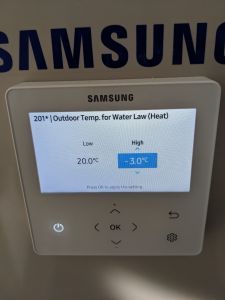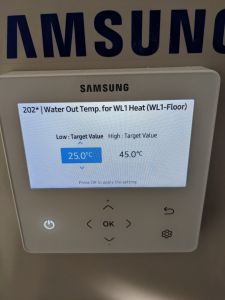Samsung 16kW R32 mono
@smit360 ok so you can use the +- 5C adjustment on there to move the water outlet temp up and down quickly, once ithe system is stablised at the new run temp , allow 60 mins at least for run temp to stabilise, more than that for the effect on the house, you start to get a feel for whether that's keeping the house warm or not you can go into the settings and change the weather comp values. this is a long iterative process, it will take you days. Plus you need a number of days at the difference ends of the temp scale of course.
buffer - integrated, nice. cleaner install than separate. buffers are always going to decrease efficiency somewhat (lots of discussion in other threads), but you've got one so we can try to optimise it. Please invest in a set of these amazon cheapo thermometers. Tape them tightly to the buffer tank pipes, there will likely be 4 . insulate over the top with 28mm pipe insulation so we get pipe temp not air temp. work out which is which - 2 will be to the heat pump (flow and return) 2 will be to the heating system (flow and return). We are going to need to know these temps later.
thermostats - just thinking, you are going to need something to tell your system to switch off when too warm, unless you achieve weather comp perfection, which very few do, you won't literally run it 24/7. I presume that your 3 zone stats been setup to call for heat from the heat pump? Are they going though some additional logic ? or are they just all wired individually to the B21 terminal (logical OR) i.e. if any zone calls, the heat pump runs?
Either you are going to need to make one of the zone stats the sole master to determine whether the heat pump runs or not. This is not desirable if it has a "boiler attitude" to cycling and run times (small hysteresis, lots of on/off switches per hour). OR , you will need to make the samsung controller itself be responsible for that. In which case it needs to be in a place where it can see a reasonable view of your desired temperature, it needs to be in the lounge or hall. not airing cupboard. Its easy to move, its got a 2 wire low voltage cable in the back that is trivial to extend.
My octopus signup link https://share.octopus.energy/ebony-deer-230
210m2 house, Samsung 16kw Gen6 ASHP Self installed: Single circulation loop , PWM modulating pump.
My public ASHP stats: https://heatpumpmonitor.org/system/view?id=45
11.9kWp of PV
41kWh of Battery storage (3x Powerwall 2)
2x BEVs
@iancalderbank thanks for the detailed reply. Last few weeks we've been moving back in and making the house as liveable as possible. It's like Beirut at the front and all new at the back.
I've attached my initial 201,202 figures. I've since changed these to the standard ones found online 201: 15, -2 and 202: 32, 47. I have 203 set to 35 and 50 and 2041 is using those values?
Regarding temps, I've attached the linked thermometers to relevant pipework at the tank with readings as followed. ASHP Flow - 38.8, ASHP Return - 34.8, Heating Flow - 35.2, Heating Return - 30.9. Outdoor temp on the display was 5.8.
The ASHP pump is set at 55w/1.4m3/h. The heating circulation pump is set on constant speed mode at 3 bars. (No visual with that one.)
I've checked that stats, they go into a junction box before the Samsung board. They are all linked together in there and then one wire sent to B21. The heating circulation pump is also in B21. Do you think the best method would be to extend the cable for the Samsung controller and mount that on the hallway?
200m2 1930's house with large modern extension.
Samsung 16kW Gen6 ASHP.
4kW PV.
Also, another question relating to the external run of pipework. The current setup is approximately 6metres, lagged and clipped to an outside wall in trunking. Due to the size of the heat pump, there was nowhere for it to be sited on what will eventually be a patio on the back of the house (currently a 4ft drop from the rear doors.)
My two options are:
- Build a steel-framed/block and beam suspended patio with access underneath to get to the heat pump and allow air flow.
- Move the heat pump to after the patio area which would extend the pipework by approximately 4metres, possibly running the underground and connecting to the wall mounted pipework. (I did see mibec DHP pipe online for this.)
I feel the latter will probably be a better solution for access with regards to servicing/maintenance, I'm just unsure of the impact if any the extra run of pipework will cause.
200m2 1930's house with large modern extension.
Samsung 16kW Gen6 ASHP.
4kW PV.
@smit360 @healcol and @ken any practical suggestion/recommendations here with the final installation spot for this heat pump?
Pre-order: The Ultimate Guide to Heat Pumps
Subscribe and follow our Homeowners’ Q&A heat pump podcast
Hi all, we've now had the heat pump moved to its final position. Flow rate is approx 25lpm.
Originally it was 3 zones - UFH, downstairs rads, upstairs rads. Each with their own stat to call for heat. UFH has own circulation pump and rads had one between both zones.
The zone control valves have been removed to make open loop circuit, my question comes to the wiring of the secondary pumps.
Currently the primary pump is connected to terminals 7 and 8 in the Samsung controller panel. (Not pwm)
The UFH heating pump was powered from the UFH stat switch live and the radiator pump from the rad stat.
I was going to use the Samsung MIM controller as the main stat and have relocated the unit into the main hallway.
How would you wire the two secondary pumps?
200m2 1930's house with large modern extension.
Samsung 16kW Gen6 ASHP.
4kW PV.
Posted by: @smit360How would you wire the two secondary pumps?
Is there a buffer between heat pump and emitters? My temptation is simply to switch them on when the primary pump comes on, but if there isn't a buffer are they actually needed?
4kW peak of solar PV since 2011; EV and a 1930s house which has been partially renovated to improve its efficiency. 7kW Vaillant heat pump.
Posted by: @smit360@jamespa thanks for the reply.
There is an integrated 50L buffer in the water tank.
Ok.
Two schools of thought. The first is to run the two sides independently, the primary triggered by the buffer temp and the secondary triggered by the room temp. The second is to control both together. The more complex alternative, which I believe is the correct way to avoid mixing, is it run them, based on measurements of buffer temperature, so that the average volumetric rate on both sides is equal, thus allowing stratification to establish within the buffer and minimising mixing. I'm not sure if any of the installers who habitually install buffers (usually for no good reason) do this though, and. 50l buffer is too small for stratification.
To my mind you want it it run as if there were no buffer, and since you have done away with the controls on the secondary side (?) I would trigger them all together from the heat pump, run the whole thing 24*7 and minimise ft unless there is a reason to do something else. I would want to arrange things so that the volumetric flow rate on the primary is a bit more than on the secondary to minimise diluting ft to the emitters. Of course this depends on what the purpose was for fitting the buffer in the first place.
That said I don't have a buffer so am by no means the expert. You may want therefore to await comments from others.
4kW peak of solar PV since 2011; EV and a 1930s house which has been partially renovated to improve its efficiency. 7kW Vaillant heat pump.
- 26 Forums
- 2,171 Topics
- 47.8 K Posts
- 53 Online
- 5,744 Members
Podcast Picks
Latest Posts
-

RE: Help me keep the faith with my air source heat pump installation
Water pump will certainly make a hum (which could conce...
By JamesPa , 16 minutes ago
-

@jamespa Thanks. Yeah any adjustments Ive made at pr...
By cliffhanger , 35 minutes ago
-

RE: Mitsu PAR-WT60R Wireless Controller - options
I have been running mine in auto adapt since 2019 and i...
By Abernyte , 2 hours ago
-

RE: Powerwall 3 or Myenergi or something else?
Many of those tariffs are simple time of use tariffs, w...
By Temperature_Gradient , 13 hours ago
-

So far as I can tell designing for DT5, which is 'the n...
By JamesPa , 13 hours ago
-

RE: Big Changes Coming to Our Heat Pump System
@editor your engineer's attitude is truly horrifying. ...
By GrahamF , 2 days ago
-

RE: How to choose Towel Rails for an ASHP
@rob-nezard yes absolutely. Here is the link and a pho...
By GrahamF , 2 days ago
-

@mixergy Thanks for the update, I would appreciate some...
By bontwoody , 2 days ago
-

RE: Is Your Broadband Router the Weak Link in Your High-Tech Home?
Unfortunately I'm not that well connected 😂 ...
By Scalextrix , 2 days ago
-

RE: A Customer's Lessons Learnt from a Heat Pump Installation in a Large House
It is interesting to see what our new Grant Aerona 290 ...
By GrahamF , 2 days ago
-

RE: Testing new controls/monitoring for Midea Clone ASHP
I've never physically seen it, but I seem to recall som...
By cathodeRay , 2 days ago
-

RE: Midea ASHP – how to set weather compensation
I noticed that too and thought the same thing, but then...
By cathodeRay , 3 days ago
-

RE: Ya can’t win! It is S*d’s Law!
@old_scientist If IOF is still running next late spring...
By Toodles , 3 days ago
-

RE: Electricity price predictions
Those of you on Agile will do well tomorrow; there are ...
By Toodles , 3 days ago
-

RE: Who’s Caved and Switched the Heating On Already?
We've been running our Ecodan system, installed in June...
By Sheriff Fatman , 3 days ago
-

Ok. Two schools of thought. The first is to run the ...
By JamesPa , 4 days ago
-

@drei Willing as I am to help, I don't think I'm yet ...
By JamesPa , 4 days ago
-

Selling 5 year old ASHP & Gas Combi Boiler - £590
Selling a 5-year-old Daikin Altherma Hybrid Air Source ...
By Paul G , 4 days ago
-

RE: Is a Valliant Inline 6kW heater a BUS buster?
Much of that is true in principle, but its not likely t...
By JamesPa , 5 days ago






